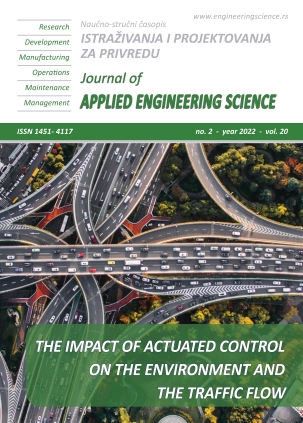THE INFLUENCE OF STEEL FIBRES AND RPC THICKNESS ON THE BEHAVIOUR OF HYBRID COLUMNS UNDER CONCENTRIC LOADING
Abstract
In this paper a test was performed on six reinforced concrete rectangular columns subjected to concentric loading up to failure. The material used in this investigation included normal concrete, NC, and reactive powder concrete, RPC. Two columns were cast as control specimens with NC and RPC. The remaining four were of hybrid combination having the NC in the centre and the RPC surrounded it. Variables investigated were the effect of steel fibre volumetric ratio, Vf, (0.5, 1 and 1.5) as well as the thickness of the external RPC part, (40 and 20) mm. The columns were of rectangular section having the dimensions of (100×200×740) mm.
Data recorded included: crack and ultimate loads as well as the longitudinal and lateral strains. Experimental results indicated that the behaviour of the hybrid reinforced concrete columns were approaching that of the full RPC.
References
Yusof, M. A., Nor, N. M., Zain, M. F. M., Peng, Ng. Ch.,Ismail, A., Sohaimi, R. M. and Ahmad, A. M., (2011). Mechanical properties of hybrid steel fibre reinforced concrete with different aspect ratio. Australian Journal of Basic and Applied Sciences, 5(7), pp. 159-166, ISSN 1991-8178.
Shah, S. (1997). High-performance concrete: controlled performance concrete. NSF center for science and technology of advanced cement-based materials, Magazine of Concrete Research, 49, 178, Mar., 1-3.
Bayasi, Z., (1989). Development and mechanical characterization of carbon fibre reinforced cement composites and mechanical properties and structural applications of steel fibre reinforced concrete, Ph.D. Thesis, Michigan State University, USA, pp: 1-199, Sited by [1].
Russell, H. G. and Graybeal, B. A (2013). Ultra-high-performance concrete: A State-of-the-Art report for the bridge community. June. Publication No. FHWA-HRT-13-060.
Berry, M., Snidarich, R. and Wood, C (2017). Development of non-proprietary ultra-high-performance concrete. Final Report prepared for The State of Montana Department of Transportation, December, Publication No. FHWA/MT-17-010/8237-001.
Wu, X., Kang, T. H. K., Mpalla, I. B. and Kim, Ch. S. (2018). Axial load testing of hybrid concrete columns consisting of UHPFRC tube and normal-strength concrete core. International Journal of Concrete Structures and Materials, DOI 10.1186/s40069-018-0275-2, ISSN 1976-0485 / eISSN 2234-1315, Published online 29, May.
Larsen, I. L., Thorstensen, R. T. (2020). The influence of steel fibres on compressive and tensile strength of ultra high performance concrete. Construction and Building Materials, V. 256, 119459. https://doi.org/10.1016/j.conbuildmat.2020.119459
HABEL, K. (2004). Structural behaviour of elements combining ultra-high-performance fibre reinforced concretes (UHPFRC) and reinforced concrete. PhD thesis, Federal Institute of Technology in Lausanne, France.
Resheq, A. (2018). Behavior of hybrid concrete columns under axial compression loads. MATEC Web of Conferences 162, 04021, https://doi.org/10.1051/mateNConf/201816204021 , BCEE3-2017.
Mohammed, A.H., Hasan, Q.A., Sarsam, K.F. (2020). The influence of reinforcement on the torsion capacity of the hybrid beams. Journal of Engineering Science and Technology Vol. 15, No. 1 (2020) 426 - 436, Web of Science [v.5.32] - Web of Science Core Collection Full Record (webofknowledge.com)
Hamid, M. M., Yassin, L. A. and Mohammed, A. H. (2020). Behavior of hybrid reinforced concrete columns. IOP Conference Series: Materials Science and Engineering: Doi:10.1088/1757-899X/737/1/012033.
Danha, L. S., Abdul-hussien, Z. A., Abduljabbar, M. S. and Yassin, L. A. (2020). Flexural behavior of hybrid ultra-high-performance concrete. IOP Conf. Series: Materials Science and Engineering 737 (2020) 012008, doi:10.1088/1757-899X/737/1/012008.
Kumar, S. A. H., Rizvi, S. H., Raza, M. S. and Ansari, J. K. (2020). Effects of steel fibres on fresh and hardened properties of concrete, Civil and Environmental Engineering Reports, Open access Published Online: 09 Nov. pp186-199 DOI: https://doi.org/10.2478/ceer-2020-0039
ASTM Designation: C39/C39M−14a (2014). Standard test method for compressive strength of cylindrical concrete specimens. ASTM International, 100 Barr Harbor Drive, PO Box C700, West Conshohocken, PA 19428-2959, United States.
ASTM Designation: C469/C469M–14 (2014). Standard test method for static modulus of elasticity and poisson’s ratio of concrete in compression. ASTM International, 100 Barr Harbor Drive, PO Box C700, West Conshohocken, PA 19428-2959, United States.
ASTM Designation: C496/C496M–11 (2011). Standard test method for splitting tensile strength of cylindrical concrete specimens. ASTM International, 100 Barr Harbor Drive, PO Box C700, West Conshohocken, PA 19428-2959, United States.
ASTM Designation: C78/C78M−10, 1(2010). Flexural strength of concrete (using simple beam with third-point loading). ASTM International, 100 Barr Harbor Drive, PO Box C700, West Conshohocken, PA 19428-2959, United States.

